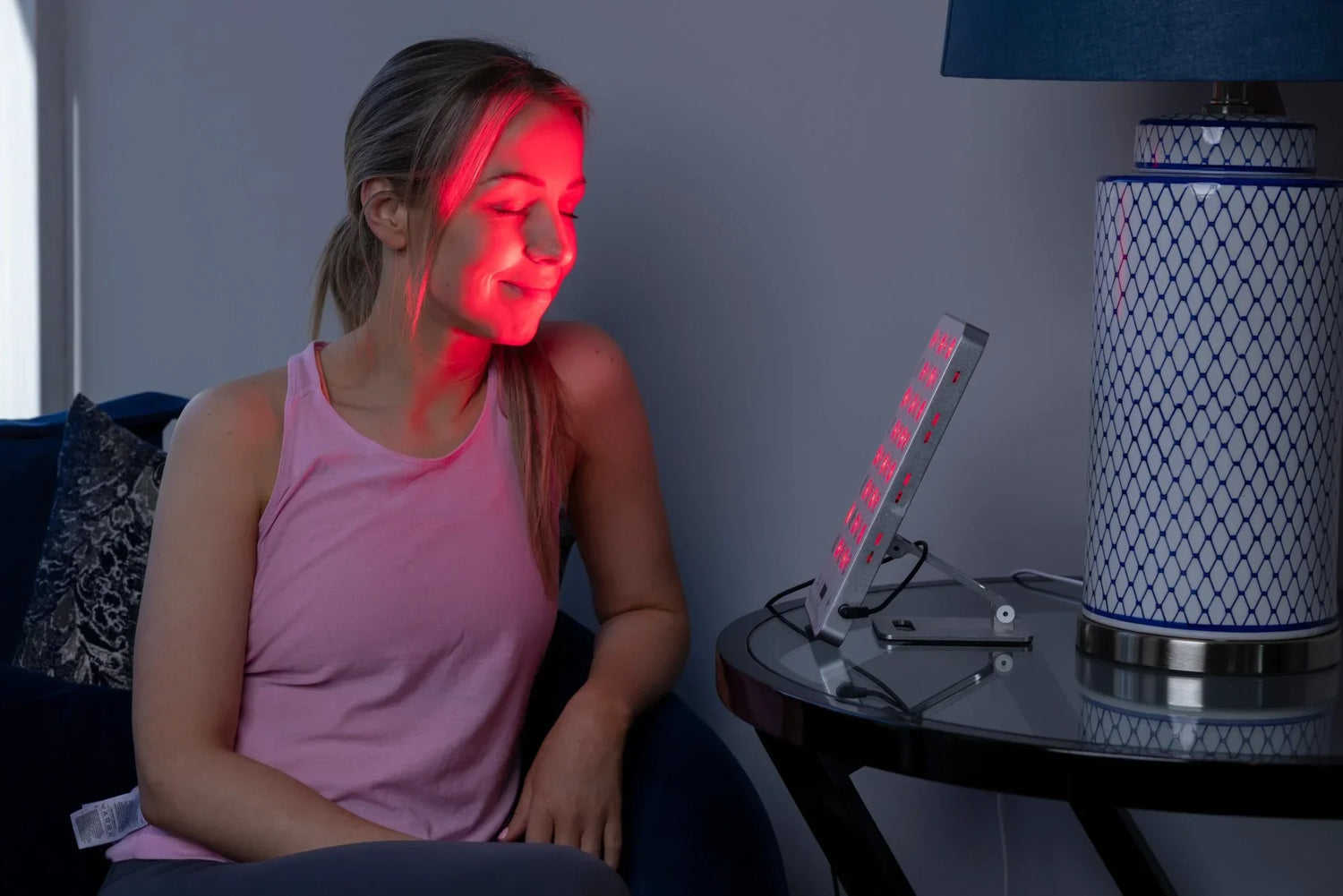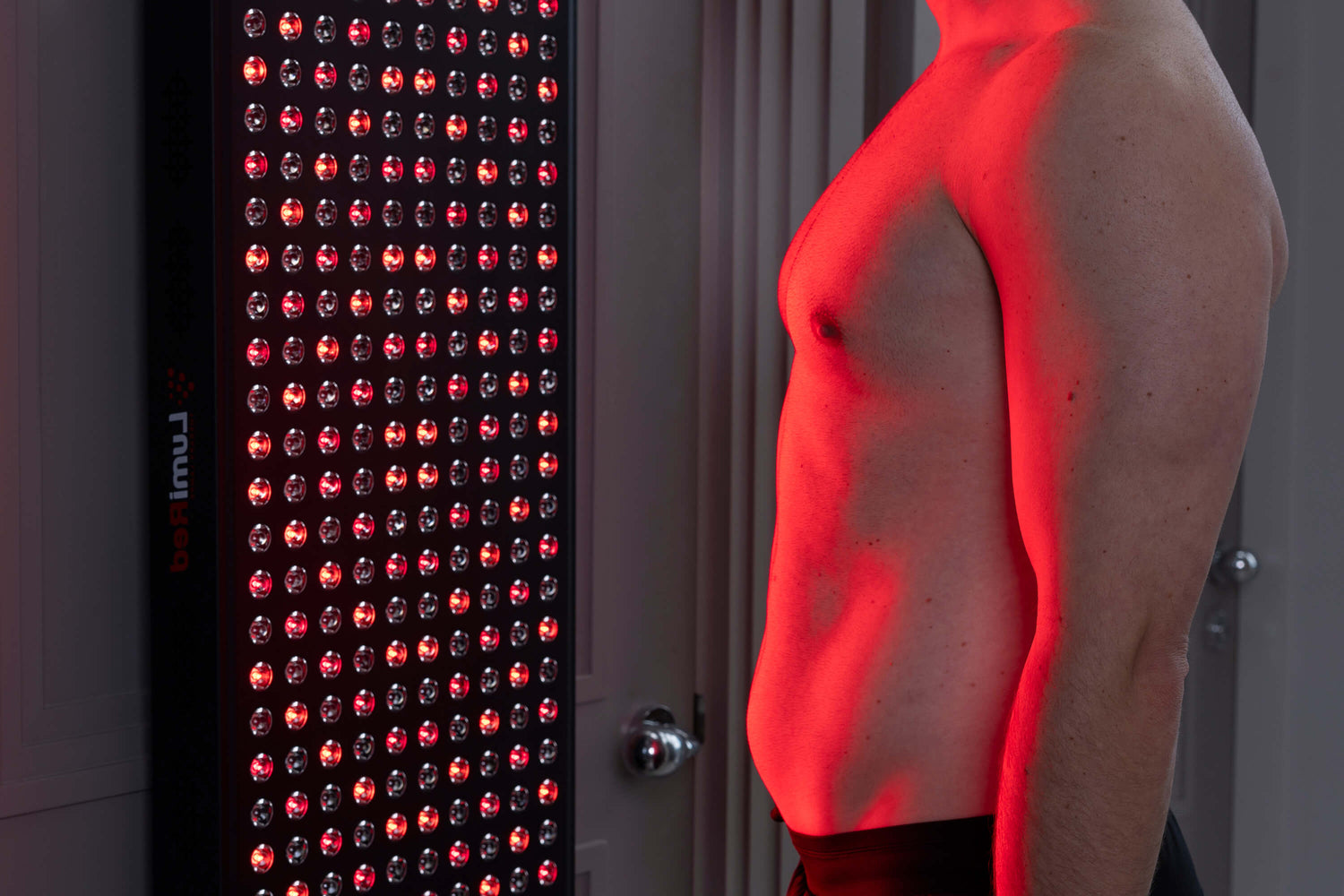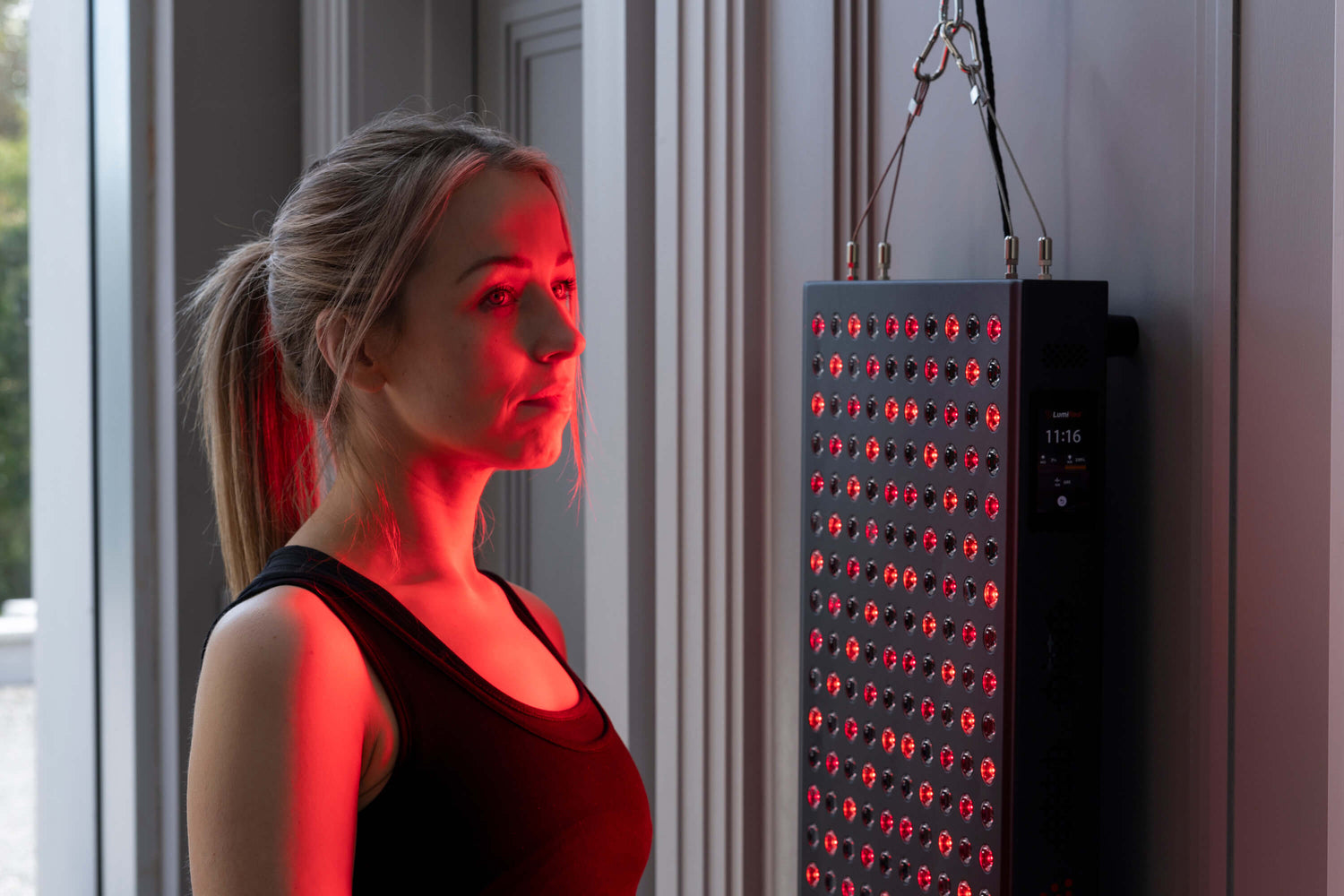If you are an active person who loves to work out, you already know the importance of muscle repair. Proper muscle recovery is essential for continuous improvements in athletic performance, results you want to achieve, and overall well-being. Nowadays, there are numerous approaches and products for muscle repair, and red light therapy is one of them. In this post, we’re going to explore red light therapy for muscle repair, whether it works, how it functions, and more.
Is red light therapy effective for muscle repair?
The effectiveness of red light therapy for muscle repair was confirmed by several studies. A good example is research from the American Journal of Physical Medicine and Rehabilitation, which found that light-emitting diode therapy can reduce muscle damage, pain, and atrophy while supporting muscle recovery, mass, and athletic performance.
Additionally, a paper from the Journal of Athletic Training found that near-infrared light therapy effectively attenuated strength loss when applied to skeletal muscle prior to resistance exercise. The study confirmed light therapy is an effective and noninvasive approach to improving muscle function.
Speaking of the efficacy of red light therapy for muscle repair, it’s also useful to mention a randomized-controlled trial from Lasers in Medical Science, which found that light-emitting diode therapy can attenuate the muscle soreness and loss of muscle strength as well as impairments in range of motion. In this study, even a single session led to improvements in muscle recovery.
One study found that phototherapy administered before resistance exercise provided ergogenic and prophylactic benefits. In this study, light therapy delayed the onset of fatigue, lowered fatigue response, protected cells from exercise-induced damage, and improved post-exercise recovery.
More research is necessary to elucidate the true potential of red light therapy for muscle repair. Current evidence confirms it can help accelerate muscle recovery.
How does red light therapy work for muscle repair?
Red light therapy gained popularity as a non-invasive and drug-free approach to support recovery and repair of muscles. Studies confirm the effectiveness of red light therapy, but it’s important to emphasize that more research is necessary to explore and elucidate everything this therapy has to offer.
Red light therapy supports muscle repair through several mechanisms of action. Let’s take a look at them below.
Antioxidant properties
Antioxidants are molecules that fight and neutralize free radicals in the body to treat or prevent oxidative stress and the damage it would cause. Oxidative stress may result from many factors, including muscle-damaging exercise. Vigorous exercise can increase levels of free radicals through elevated activation of aerobic bioenergetic pathways and exercise-induced hyperthermia.
Short-term oxidative stress isn’t such a serious problem, but chronic oxidative stress is a major issue. Evidence shows chronic oxidative stress is linked to increased protein loss and muscle atrophy. The deleterious effects, such as muscle atrophy and reduction of force generation, result mainly from non-regular strenuous exercise.
Oxidative stress is bad news for your muscles, but this is where red light therapy steps in. Red light therapy can protect against free radicals and oxidative stress, evidence shows. A study from the journal PLoS Onefound that the administration of red and infrared laser therapy positively modulates antioxidant enzymes and lowers stress markers during the process of muscle repair.
The same paper reported that red light therapy exhibits protective effects on muscle tissue as it modulates mitochondrial activity. Red light therapy can modulate oxidative stress and thereby help muscles recover. It’s useful to mention that antioxidant levels determine the regenerative capacity of muscle stem cells. Red light therapy works to improve the regenerative capacity and reduce muscle damage.
Anti-inflammatory effects
Intense long exercise can contribute to higher levels of inflammatory mediators. This can lead to chronic inflammation and a higher risk of injury. Studies show exercise can increase pro-inflammatory cytokines, but it’s useful to keep in mind that the duration of exercise determines the magnitude or intensity of the inflammatory state.
Inflammation can lead to muscle depletion and contributes to muscle damage. For that reason, inflammatory response worsens muscle injury.
A proper muscle repair approach should exhibit anti-inflammatory effects in order to tackle this problem and avoid further damage and injury risk. That happens to be one of several mechanisms of action of red light therapy. The anti-inflammatory effects of photobiomodulation (or red light therapy) are scientifically confirmed. For instance, a paper from AIMS Biophysics explained that red light therapy can reduce inflammatory markers such as interleukin 1β (key mediator of inflammatory response) and muscle atrophy.
Thanks to the anti-inflammatory effects, red light therapy can minimize soreness and swelling. As a result, it helps with muscle repair.
Improved blood circulation
Proper function and well-being of your muscles depend on blood flow just like the rest of your body. Healthy blood flow supplies the muscles with fresh blood and oxygen while delivering much-needed nutrients. At the same time, blood circulation carries away the muscles’ wastes back to your kidneys. This is important because optimal waste management supports muscle recovery and repair, reduces soreness after a workout, and improves overall tissue health.
Since blood circulation is vital for muscle health, impaired blood flow can worsen muscle damage and complicate repair or recovery. Low blood volume causes inefficient functioning of muscles. The muscles don’t get oxygen-rich blood and nutrients properly. When that happens, it becomes difficult for muscles to recover and repair. The risk of injuries is also higher in such a scenario.
One of the most significant benefits of red light therapy is that it improves blood flow to the muscles. Increased circulation speeds up the healing process. Studies show that increasing blood flow in tissue exposed to red light therapy would increase the delivery of oxygen and other substrates to exercising muscles. This increases the ability of that specific muscle to perform work.
Red light therapy stimulates the release of nitric oxide. This molecule is a vasodilator meaning it spreads your blood vessels. As a result, blood circulation improves so that your muscles can repair and function properly.
Increased production of collagen
Collagen is a protein that is responsible for healthy joints and skin. This protein is vital for strong and healthy muscles. Collagen forms a sheath around muscle fibers, thus giving them both support and protection. It’s important to mention that collagen is a crucial component of a system that connects muscular cells and groups them. Impaired collagen and low levels of this protein can thereby worsen muscle damage and make it difficult for your muscles to repair and recover properly.
Red light therapy supports muscle repair by stimulating the production of collagen. Increased production of collagen strengthens muscle fibers and makes them more resilient.
How to use red light therapy for muscle repair?
Red light therapy for muscle repair works through several mechanisms of action. Using red light therapy to repair and recover your muscles is a simple and straightforward process.
A full body panel from the LumiRed or LumiPro series allows the full body to be treated, front and back in as little as 20 minutes, This is easy to administer after workouts or later in the day to boost the bodies recovery process and get you ready for your next workout.
You can use red light therapy for muscle repair in different situations. Good examples are:
- Alleviating post-workout soreness
- Promoting the healing process after injury
- Workout preparation for better athletic performance and lower injury risk
- Management of chronic pain
- Rest and relaxation
Red light therapy has a wide range of benefits, but the most significant advantage is its safety. The whole process is painless and doesn’t cause side effects or complications. Most clients find red light therapy sessions relaxing and consider them the perfect me-time opportunity.
Conclusion
The importance of proper muscle repair is often overlooked. Muscle repair is vital for the proper functioning of these tissues, their strength, athletic performance, and range of motion. Inadequate repair of muscles doesn’t allow you to get the most from your exercise or any other activity. One of the most effective approaches to achieving muscle repair or recovery is red light therapy. A growing body of evidence confirms the effectiveness of red light therapy on muscle repair. Red light therapy works through several mechanisms of action to deliver its effects. The whole process is safe, relaxing, and adapted to the specific needs of each person.
References
Ferraresi C, Bertucci D, Schiavinato J, et al. Effects of Light-Emitting Diode Therapy on Muscle Hypertrophy, Gene Expression, Performance, Damage, and Delayed-Onset Muscle Soreness: Case-control Study with a Pair of Identical Twins. Am J Phys Med Rehabil. 2016;95(10):746-757. doi:10.1097/PHM.0000000000000490
Larkin-Kaiser KA, Christou E, Tillman M, George S, Borsa PA. Near-infrared light therapy to attenuate strength loss after strenuous resistance exercise. J Athl Train. 2015;50(1):45-50. doi:10.4085/1062-6050-49.3.82
Borges LS, Cerqueira MS, dos Santos Rocha JA, et al. Light-emitting diode phototherapy improves muscle recovery after a damaging exercise. Lasers Med Sci. 2014;29(3):1139-1144. doi:10.1007/s10103-013-1486-z
Borsa PA, Larkin KA, True JM. Does phototherapy enhance skeletal muscle contractile function and postexercise recovery? A systematic review. J Athl Train. 2013;48(1):57-67. doi:10.4085/1062-6050-48.1.12
Chen TC, Huang YC, Chou TY, Hsu ST, Chen MY, Nosaka K. Effects of far-infrared radiation lamp therapy on recovery from muscle damage induced by eccentric exercise. Eur J Sport Sci. 2023;23(8):1638-1646. doi:10.1080/17461391.2023.2185163
Jamurtas AZ. Exercise-Induced Muscle Damage and Oxidative Stress. Antioxidants (Basel). 2018;7(4):50. Published 2018 Mar 28. doi:10.3390/antiox7040050
Steinbacher P, Eckl P. Impact of oxidative stress on exercising skeletal muscle. Biomolecules. 2015;5(2):356-377. Published 2015 Apr 10. doi:10.3390/biom5020356
Walski T, Drohomirecka A, Bujok J, et al. Low-Level Light Therapy Protects Red Blood Cells Against Oxidative Stress and Hemolysis During Extracorporeal Circulation. Front Physiol. 2018;9:647. Published 2018 May 31. doi:10.3389/fphys.2018.00647
Ribeiro BG, Alves AN, Dos Santos LA, et al. Red and Infrared Low-Level Laser Therapy Prior to Injury with or without Administration after Injury Modulate Oxidative Stress during the Muscle Repair Process. PLoS One. 2016;11(4):e0153618. Published 2016 Apr 15. doi:10.1371/journal.pone.0153618
Cerqueira É, Marinho DA, Neiva HP, Lourenço O. Inflammatory Effects of High and Moderate Intensity Exercise-A Systematic Review. Front Physiol. 2020;10:1550. Published 2020 Jan 9. doi:10.3389/fphys.2019.01550
Hamblin MR. Mechanisms and applications of the anti-inflammatory effects of photobiomodulation. AIMS Biophys. 2017;4(3):337-361. doi:10.3934/biophy.2017.3.337
Keszler A, Lindemer B, Weihrauch D, Jones D, Hogg N, Lohr NL. Red/near infrared light stimulates release of an endothelium dependent vasodilator and rescues vascular dysfunction in a diabetes model [published correction appears in Free Radic Biol Med. 2019 Feb 1;131:443]. Free Radic Biol Med. 2017;113:157-164. doi:10.1016/j.freeradbiomed.2017.09.012
Li WH, Seo I, Kim B, Fassih A, Southall MD, Parsa R. Low-level red plus near infrared lights combination induces expressions of collagen and elastin in human skin in vitro. Int J Cosmet Sci. 2021;43(3):311-320. doi:10.1111/ics.12698




